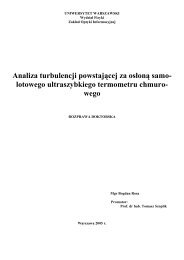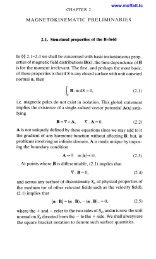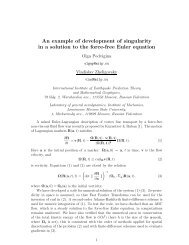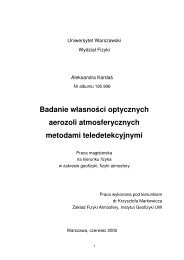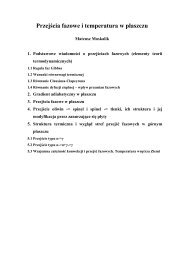A class of solutions of the Einstein-Maxwell equations
A class of solutions of the Einstein-Maxwell equations
A class of solutions of the Einstein-Maxwell equations
Create successful ePaper yourself
Turn your PDF publications into a flip-book with our unique Google optimized e-Paper software.
A <strong>class</strong> <strong>of</strong> <strong>solutions</strong> <strong>of</strong> <strong>the</strong> <strong>Einstein</strong>-<strong>Maxwell</strong> <strong>equations</strong><br />
Konrad BajeP)<br />
Institute for Theoretical Physics, University <strong>of</strong> Warsaw, 00-681 Warsaw, Poland<br />
Jetzy Klemens Kowalczyfiskib)<br />
Departamento de Fkica, Centro de Investigacion y de Estudios Avanzados del I.P.N., AP 14-740. Mexico 14,<br />
D.F., Mexico<br />
(Received 6 October 1983; accepted for publication 9 August 1984)<br />
We present all <strong>the</strong> exact <strong>solutions</strong> <strong>of</strong> <strong>the</strong> <strong>Einstein</strong>-<strong>Maxwell</strong> <strong>equations</strong> for a special case <strong>of</strong> <strong>the</strong><br />
Robinson-Trautman metric form. Gaussian curvature <strong>of</strong> <strong>the</strong> angularlike part <strong>of</strong> <strong>the</strong> chosen<br />
metric form is equal to zero. The <strong>solutions</strong> are <strong>of</strong> <strong>the</strong> Petrov types D or 11. Eight <strong>of</strong> <strong>the</strong>m are<br />
probably new.<br />
1. INTRODUCTION<br />
In this paper we present all <strong>the</strong> exact <strong>solutions</strong> <strong>of</strong> <strong>the</strong><br />
<strong>Einstein</strong>-<strong>Maxwell</strong> <strong>equations</strong> (without currents)<br />
Gpv = - RgpV + 2(FppFvp + &pvFprFPr),<br />
FL, 1 = 0, F pv,v = 0, (1.1)<br />
assuming only <strong>the</strong> limitation<br />
ds2=4p2dYd?+2dpdq +p-'(2mp + f)dq2. (1.2)<br />
The meanings <strong>of</strong> symbols are as follows: Gpv, gpv , and<br />
Fpv are <strong>the</strong> <strong>Einstein</strong>, metric, and electromagnetic field tensors,<br />
respectively, R is <strong>the</strong> cosmological constant, Y is a complex<br />
coordinate, p and q are real coordinates, m is an arbi-<br />
trary real constant, andf=f(Y,?,p,q)<br />
is a disposable real<br />
function that belongs to <strong>class</strong> C '. Here and below every symbol<br />
with an overbar means a complex conjugate quantity <strong>of</strong><br />
<strong>the</strong> given symbol.<br />
The signature is + + + - .<br />
The metric form (1.2) is a special case <strong>of</strong> <strong>the</strong> Robinson-<br />
Trautman one.' The Gaussian curvature <strong>of</strong> every two-dimensional<br />
surface p,q = const (p # 0) is equal to zero for<br />
space-times (1.2).'Such a geometrical property <strong>of</strong> space-time<br />
has a special physical interpretation in <strong>the</strong> case <strong>of</strong> <strong>the</strong> Robinson-Trautman<br />
type space-times. Namely, <strong>the</strong> interpretation<br />
has been given that <strong>the</strong> sources <strong>of</strong> fields, that produce <strong>the</strong><br />
Riemannian curvature <strong>of</strong> <strong>the</strong>se space-times, move with <strong>the</strong><br />
speed <strong>of</strong> light. '*' Thus <strong>the</strong> <strong>solutions</strong> presented below make it<br />
possible to find explicitly <strong>the</strong> detailed properties <strong>of</strong> all such<br />
space-times admitted by <strong>the</strong> <strong>Einstein</strong>-<strong>Maxwell</strong> <strong>the</strong>ory within<br />
<strong>the</strong> limitation (1.2).<br />
In Sec. I1 some general properties <strong>of</strong> <strong>the</strong> <strong>solutions</strong> are<br />
briefly reviewed. In Sec. I11 a list <strong>of</strong> <strong>the</strong> explicit <strong>solutions</strong> and<br />
Petrov's <strong>class</strong>ification are given.<br />
II. SOME GENERAL PROPERTIES<br />
When solving Eqs. (1.1) under condition (1.2) we used<br />
<strong>the</strong> known results3 that include expressions ready for inte-<br />
')Present and permanent address: Institute <strong>of</strong> Geophysics, University <strong>of</strong><br />
Warsaw, U1. Pasteura 7,02-093 Warsaw, Poland.<br />
b)On leave <strong>of</strong> absence from <strong>the</strong> Institute <strong>of</strong> Physics, Polish Academy <strong>of</strong> Sciences,<br />
Warsaw, Poland. Present and permanent address: Institute <strong>of</strong><br />
Physics, Polish Academy <strong>of</strong> Sciences, Al. Lotnik6w 32/46,02-668 Warsaw,<br />
Poland.<br />
grati~n.~ After easy integration <strong>of</strong> a part <strong>of</strong> those expressions<br />
one finds that<br />
f= -f/2p4+pA-BB (2.1)<br />
and<br />
-<br />
A =A, A,, = A,y = A,p = 0,<br />
-<br />
C,y = C,y = C,p = 0, A,, = 2CC (2.2)<br />
for B = 0, where C is an arbitrary complex function <strong>of</strong> q<br />
only, and<br />
-<br />
A =A, A,p = 0, B,y = B,p = 0,<br />
(2.3a)<br />
A,eB -A, yB,y + 4B2B,, = 0,<br />
(2.3b)<br />
A, yA,y - 8A,,BB = 0 (2.3~)<br />
for B #O.<br />
The electromagnetic field is given by <strong>the</strong> following<br />
<strong>equations</strong>:<br />
F- = F, = F, = 0, Fyq = C (2.4)<br />
for B = 0, and<br />
Fyp = 0,<br />
-<br />
Fyy = B - B, F, = - Jp-'(B + B),<br />
-<br />
Fyq = Jp-lB,, - V9yB-l<br />
(2.5)<br />
for B #O.<br />
It is well known that R is introduced into <strong>the</strong> Robinson-<br />
Trautman metrics in a very simple way.5 This causes <strong>the</strong><br />
absence <strong>of</strong>R in Eqs. (2.2) and (2.3). Thus Eqs. (2.2)-(2.5) are<br />
special cases <strong>of</strong> <strong>the</strong> more general <strong>equations</strong> that have been<br />
given by Robinson et aL6<br />
It is easy to see from Eqs. (1.2) and (2.1) that real function<br />
A is determined with an accuracy up to an arbitrary<br />
additive real constant since m is arbitrary. Thus condition<br />
A = const is equivalent to condition A = 0.<br />
The following transformations:<br />
Y= Y'+a, Y= Y'eia, q=q'+b (2.6)<br />
do not change Eqs. (1.2) and (2.1)-(2.5) for arbitrary constants<br />
a, a, and 6, where a is complex and a and b are real.<br />
In each <strong>of</strong> our space-times <strong>the</strong> vector field k p: = determines<br />
a congruence <strong>of</strong> <strong>the</strong> principal null curves <strong>of</strong> <strong>the</strong><br />
electromagnetic field since it is a conclusion from Eqs. (1.2),<br />
(2.4), and (2.5) that kIpFvlpkP = 0 and kpk" = 0. The last<br />
equation means that metric form (1.2) is also <strong>the</strong> Kerr-Schild<br />
1330 J. Math. Phys. 26 (6), June 1985 0022-2488/85/061330-04$02.50 0 1985 American Institute <strong>of</strong> Physics 1330
metric form since dq = k,,da+. It is easy to prove (see, e.g.,<br />
Refs. 3 and 4) that vector k“ is geodetic, shear-free, rotationfree,<br />
its expansion does not vanish, and that it is a double<br />
Debever-Penrose vector.<br />
111. LIST OF SOLUTIONS AND PETROV’S<br />
CLASSIFICATION<br />
The explicit <strong>solutions</strong> <strong>of</strong> Eqs. (2.2) and (2.3) are as follows:<br />
J<br />
”<br />
A=2 CCdq, B=O,<br />
A = 0, B = 4 (Y),<br />
where 4 is an arbitrary analytic function <strong>of</strong> Y only,<br />
A = 4ab(Y+ F) + k’q, B = be“, (3.3)<br />
A = bb-+ k’q, B = bY, (3.4)<br />
A = - 8a2q-1ey+p , B = ae’, (3.5)<br />
A = - *a’( Y + P)2q-’/3 + bbi( Y - f) + 6b 2q1/3,<br />
B = ~&q’/~, (3.6)<br />
A = 2a2[ - 2x-+ b (Y’ + P’)](x’ - b ’)-’<br />
+ [2ac(Y + 7) - c21(x + b )-I<br />
+ [2agi(Y- P) -$I(x - b I-’,<br />
B = ae” (x’- b ’),<br />
(3.7a)<br />
where <strong>the</strong> auxiliary real variable x is determined by <strong>the</strong> equation<br />
q = p’ - tb’X3 + 2b4x,<br />
(3.7b)<br />
A=k%i(lnF-ln Y)+2a2b2q, B=aeib4Y-’,<br />
(3.8)<br />
A= -2a2(1+bz31n~--’(1-bbi)lnP<br />
(3.9)<br />
B = bemqYa- I, aE + 2(a + E) = 0, (3.10)<br />
A = - k 2kq - aEk YaFE, B = aq2akya - 1 9<br />
k -’ = aE + 2(a + E)#O,<br />
A = 2ab (Y -’ + y-’) + 2azq( Y?)-’,<br />
(3.1 1)<br />
B = eu(aqY -’ + by<br />
-I), (3.12)<br />
A = -@-1/3(aY7+<br />
b)’, B = aql/’Y, (3.13)<br />
where a is a complex constant arbitrary up to <strong>the</strong> appropriate<br />
limitations given in relations (3.10) and (3.1 l), and a, 6, c,<br />
g, and h are arbitrary real constants. When integrating Eqs.<br />
(2.3) one obtains more complicated expressions for A and B<br />
than ours at right-hand sides <strong>of</strong> Eqs. (3.3H3.13). Those expressions<br />
include more arbitrary constants but <strong>the</strong>y can be<br />
reduced to Eqs. (3.3H3.13) by means <strong>of</strong> transformations<br />
(2.6). When obtaining solution (3.5) <strong>the</strong> transformation<br />
Y = cY ’, p = c- %‘, q = cq‘ has also been used. The same<br />
transformation has also been used to get a special case <strong>of</strong><br />
solution (3.11), i.e., when Rea = 1 and Ima#O. If a = 1,<br />
<strong>the</strong>n solution (3.1 1) is a special case <strong>of</strong> solution (3.7).<br />
The above list includes aZZ <strong>the</strong> exact <strong>solutions</strong> <strong>of</strong> Eqs.<br />
(1.1) with limitation (1.2). A pro<strong>of</strong> <strong>of</strong> this <strong>the</strong>orem is given in<br />
Appendices A, B, and C.<br />
Solution (3.1) has been given by Robinson and Trautman,’<br />
solution (3.2) by many author^,^*^*' and <strong>solutions</strong> (3.4),<br />
(34, and (3.13) have been given by Leroy.8 The remaining<br />
<strong>solutions</strong> seem to be new [special cases <strong>of</strong> <strong>solutions</strong> (3.9),<br />
(3.10), and (3.11) have also been given in Ref. 81.<br />
Each <strong>of</strong> our metrics is conformally flat if and only if<br />
2m +A = B = 0 (or equivalently m =A = B = 0).<br />
When determining <strong>the</strong> Petrov types <strong>of</strong> our <strong>solutions</strong> we<br />
used Lemma 1 from Ref. 3 (cf. Ref. 4) since <strong>the</strong> premise <strong>of</strong><br />
that lemma holds in <strong>the</strong> case <strong>of</strong> our metrics. It appears that<br />
only solution (3.1) is <strong>of</strong> type [2,2] (Penrose’s notation). The<br />
remaining <strong>solutions</strong> are <strong>of</strong> type [2,1,1] with possibilities <strong>of</strong><br />
fur<strong>the</strong>r degenerating to type [2,2]. More precisely, for each<br />
one <strong>of</strong> our <strong>solutions</strong> we have <strong>the</strong> following: if it is not conformally<br />
flat, <strong>the</strong>n it is <strong>of</strong> type [2,2] if and only if all <strong>equations</strong><br />
2(2m +A )A,n - 3(A,y)’ = 0,<br />
(3.14a)<br />
(2m+A)B,yy +M,yyB-4A,yB,y=O, (3.14)<br />
3BB,, - 4(B,y)’ = 0<br />
(3.14~)<br />
hold toge<strong>the</strong>r.<br />
ACKNOWLEDGMENT<br />
One <strong>of</strong> us (JKK) wishes to thank Pr<strong>of</strong>essor Jerzy Plebanski<br />
for his hospitality during <strong>the</strong> stay <strong>of</strong> <strong>the</strong> author at <strong>the</strong><br />
Centro de Investigacion del I.P.N. in Mexico City.<br />
APPENDIX A INTRODUCTORY REMARKS AND THE<br />
FIRST STEP OF THE PROOF<br />
Our pro<strong>of</strong> <strong>of</strong> <strong>the</strong> <strong>the</strong>orem, saying that Eqs. (2.1) and<br />
(3.1H3.13) areall<strong>solutions</strong><strong>of</strong>Eqs. (1.1) withlimitation (1.2),<br />
is too long to allow its presentation here in totality. Therefore,<br />
we give here only its scheme, putting emphasis on <strong>the</strong><br />
more important items so as to permit anybody interested to<br />
easily carry out <strong>the</strong> pro<strong>of</strong> himself in detail.<br />
Notation: D, E, F, ... are complex functions <strong>of</strong> two variables,<br />
Y and q, analytic in Y (or <strong>of</strong> f and q analytic in P for <strong>the</strong><br />
symbol with an overbar). K, L, M,... are disposable complex<br />
functions <strong>of</strong> one real variable q; a is an arbitrary complex<br />
constant; a and b are arbitrary real constants. An integer<br />
subscript at any symbol does not change <strong>the</strong> above meaning<br />
<strong>of</strong> <strong>the</strong> symbol.<br />
Assuming B = 0 one immediately obtains (3.1) from<br />
(2.2). Thus, henceforth, we put<br />
B #O.<br />
Integrating (2.3b) we get<br />
A,, = - 4z (D + FB,q),<br />
(All<br />
where D is a disposable function.<br />
Assuming B,, = B,, = 0 we easily obtain from (A2)<br />
and (2.3~) that D = a and <strong>the</strong>n solution (3.3).<br />
Let us assume B,, = 0 and B,, #O. If D = 0, <strong>the</strong>n by<br />
(A2),(2.3c), and (Al) we immediately obtain solution (3.2). If<br />
D #O, <strong>the</strong>n by <strong>the</strong> fact that A,fi = 2,- and by (A2) we get<br />
B,, ID = K, =El #O, and <strong>the</strong>n from (2.3~) we obtain<br />
B,yyz,FK; + 2B,,zK1,, = 0. Assuming B,,, = 0 we easi-<br />
1331 J. Math. Phys., Vol. 26, No. 6, June 1985 K. Bajer and J. K. Kowalczyhski 1331
ly get solution (3.4). Assuming B,,,#O we obtain solution<br />
(3.5) after a short calculation.<br />
Thus all possibilities are exhausted for B,, = 0 and<br />
henceforth, we put<br />
B,, #O. (A31<br />
Assuming B,, = 0 we obtain by <strong>the</strong> fact that<br />
A,* = z,-,, and by (A2) that B = L,e" and L, = z,, and<br />
<strong>the</strong>n taking (2.3c),,y and (A2) we find that D = YM, + N,.<br />
Now from (2.3~) we obtain among o<strong>the</strong>rs that M, = aL c2<br />
andL,,,L f = (bL, + aZ)'". Then after simple calculations<br />
we find solution (3.6) forb = 0 and solution (3.7) for b #O.<br />
Thus all possibilities are exhausted for B,, = 0 and<br />
henceforth, we put<br />
B,y #O.<br />
Assumption:<br />
1 +(B,,'B),,=O. (A51<br />
From (A5) we have B = (Y + K2)-'L2 and <strong>the</strong>n by <strong>the</strong><br />
fact that A,,-, =x,yy and by (A2) we obtain D<br />
= (Y + K2)-2(z'; 'M2 - K,,,K,L2) + (Y + K2)-'L2,,K2,<br />
whereM, is real. Then from (2.3~) we get M2 = K,,, = 0 and<br />
L,,,z2 = a#O. Putting L, = N, exp iP2, where N2 and P2<br />
are real, we obtain among o<strong>the</strong>rs (N:),, = a and <strong>the</strong>n after<br />
short calculations we get solution (3.8) for a = 0 and solution<br />
(3.9) for a#O.<br />
Now we begin <strong>the</strong> more complicated part <strong>of</strong> <strong>the</strong> pro<strong>of</strong>.<br />
Assumption:<br />
1 + (BY, 'B I,, #O. (A61<br />
Since A,,-, = 2,- we obtain from (A2) and (A6) that<br />
D = (BE),,, (A74<br />
B,, = (BF),y,<br />
where<br />
E:= YL+K, K=K,<br />
(A7b)<br />
F:=YM+L#O, M=B. (AW<br />
Inequality F #O results from (A3) and (A7b).9 Then <strong>the</strong> integration<br />
<strong>of</strong> (A2) gives us<br />
A = - 4[BB(K + LY+ LY + MY?) + N 3,<br />
and by (A2) and (A7)-(A9) we get from (2.3~) that<br />
B,,[i?(Y+J)'+ 3BP(Y+J)]<br />
where<br />
N = R,<br />
(A91<br />
+B [R(Y+J)+B(P+2m,,)] +2N,, =0, (A10)<br />
G = B,,F2 + 3BFM,<br />
H: = 3G + B (2F,, - 4FM),<br />
J: = EF - = (YE + K )( YM + L ) - I,<br />
P = LL - KM = F.<br />
(A131<br />
(A141<br />
Assuming G = 0 we obtain M #O and B = QF-3 from<br />
(A1 1) and <strong>the</strong>n from (A10) we get N,q = H = P = J,, = 0,<br />
which leads via a short calculation to a special case <strong>of</strong> solution<br />
(3.12) (i.e., if b = c = 0 <strong>the</strong>re).<br />
Henceforth, we put<br />
G #O. (A151<br />
APPENDIX B: CONTINUATION OF ASSUMPTION (A6)<br />
FORP=O<br />
Relations (Al)-(A4) and (A6)-(Al5) hold here. Assumption<br />
P = 0 gives us<br />
--<br />
M#O, J=zM-', A= -4(BBFFM-'+N).<br />
(B1)<br />
Integrating (A10) we find B and <strong>the</strong>n differentiating <strong>the</strong><br />
result once with respect to 7 and several times with respect<br />
to Y we get rid <strong>of</strong> B and <strong>the</strong> integrals. In consequence we<br />
obtain a product equal to zero <strong>of</strong> an expression different<br />
from zero and <strong>of</strong> a polynomial <strong>of</strong> Y. Thus <strong>the</strong> coefficients <strong>of</strong><br />
<strong>the</strong> polynomial, which depend on Pand q, are equal to zero.<br />
This procedure should be conducted twice, separately for<br />
Ntq = 0 and N,, #O.<br />
This gives us among o<strong>the</strong>rs<br />
H = QIG, BFJ,, = Q2G<br />
for N,, = 0, and<br />
J,, = 0, H(H,y - G,y) = 0<br />
for N,, # 0.<br />
Assumption:<br />
(B2)<br />
(B3)<br />
N,, = 0.<br />
(B4)<br />
Assuming J,, #O (eQ,#O) and taking into account<br />
(A11) we find B from <strong>the</strong> second equation <strong>of</strong> (B2) and <strong>the</strong>n<br />
substituting such a B into (A10) we obtain a contradictory<br />
result J,q = 0. Thus J,q = 0, which after <strong>the</strong> first transformation<br />
from (2.6) gives us<br />
F = MY.<br />
(B5)<br />
Assuming Q, = 3 we get from (B2),(A12), and (B5) that<br />
M= - (2q)-' and <strong>the</strong>n from (AlO),(Bl), and (2.3~) we obtain<br />
a special case <strong>of</strong> solution (3.12)(i.e., if b = c = 0 <strong>the</strong>re).<br />
Assuming Q, #3 we get from (B2) that In B = In Q3<br />
- [M2(5- 3Ql) + 2M,,]M-2(3 - Q,)-' In Yand <strong>the</strong>n by<br />
(Bl) we obtain Q,,, = 0 and an explicit expression <strong>of</strong> Q3(q)<br />
from (A2), (A7a), and (2.3~). Putting Q, = 1 -a we get<br />
2M,, + M2[aE + 2(a + Z)] = 0 from (A10) and <strong>the</strong>n we<br />
obtain solution (3.10) for M,, = 0 and solution (3.11) for<br />
Mq # 0.<br />
Assumption:<br />
N,, #O.<br />
(B6)<br />
Since J,, = 0 [see (B3)] thus (B5) holds also here.<br />
If we assume H = 0, <strong>the</strong>n it is easy to see that B which<br />
fulfills both (A10) and (A12) contradicts (A6). Thus, H #O<br />
and we obtain H,y = G,, from (B3). Assuming G,,#O and<br />
differentiating (A10) with respect to Ywe get a contradiction<br />
with (A6). Thus we have G,, = H,, = 0.<br />
Inequality H #3G contradicts (A6) by (A12) and (B5).<br />
Thus, H = 3Gand we obtainM = - (2q)-' from (A12) and<br />
(B5). Then integrating (A10) weget from (Bl) and (2.3c), after<br />
a simple calculation, solution (3.12).<br />
APPENDIX C: CONTINUATION OF ASSUMPTION (A6)<br />
FOR P#O<br />
Relations (Al)-(A4) and (A6)-(A15) hold here. Applying<br />
for P #O, <strong>the</strong> procedure that is described in <strong>the</strong> second<br />
1332 J. Math. Phys., Vol. 26, No. 6, June 1985 K. Bajer and J. K. Kowalczynski 1332
paragraph <strong>of</strong> Appendix B, we obtain<br />
(HG-'),, = 0, (C14<br />
P + 2FJ,,, = 0<br />
(CW<br />
for N,q = 0, and among o<strong>the</strong>rs<br />
(HG-'),y(G,y -H,y)=O<br />
(C2)<br />
for N,q # 0.<br />
Let us assume N,q = 0. Relations (A4),(AlO),(A15),<br />
and (Clb) give us <strong>the</strong>n H #O. Thus, from (Cla) we obtain<br />
H=xG and R #O. Then (A10) and (Clb) give us<br />
where R, = J + 3BPG -I. Substitut-<br />
B = R,(Y + zJvR,<br />
ing such a B into <strong>the</strong> latter [taking into account (A1 l)] we get<br />
a polynomial <strong>of</strong> Y equal to zero. Its coefficients (equal to<br />
zero) give us a system <strong>of</strong> algebraic <strong>equations</strong> involving L, z,<br />
M, R, R,, and E2. The system appears to be self-contradictory<br />
by <strong>the</strong> fact that F, P, R #O. Thus we have<br />
NSq #O.<br />
(C3)<br />
Let us assume H = 0 and split our considerations into<br />
two separate cases M = 0 and M # 0. The procedures are <strong>the</strong><br />
same in both cases. We integrate (A12) getting B 's and <strong>the</strong>n<br />
after substitution <strong>of</strong>those B 's into (A10) we obtain contradictionswith(A4)forM=<br />
Oby(C3),andwith(A6)forM #Oby<br />
(C3),(A4), and (A15).<br />
Thus we have H #O and assuming H,, = 0 we get<br />
G,, = 0 from (C2). If H #3G, <strong>the</strong>n from (A12) we obtain<br />
contradictions with (A4) for = 2M2 and with (A6) for<br />
M,q # 2M '. Thus we have H = 3G. Integrating (A11) we get<br />
B that after substitution into (A 10) gives us a polynomial <strong>of</strong> Y<br />
equal to zero. Its coefficients give us a self-contradictory system<br />
<strong>of</strong> <strong>equations</strong> depending on ?and q. The contradictions<br />
are caused by (A15) and equation H = 3G for M = 0 and by<br />
(A6) and assumption P #O for M #O. Thus we have<br />
H,y#O.<br />
The most general solution <strong>of</strong> (C2) is<br />
(C4)<br />
H= GS+ T, (S- l)T=O, (C5)<br />
which by (C4) gives us<br />
G, y s # 0. (C6)<br />
Differentiating (A10) with respect to 7, <strong>the</strong>n dividing it<br />
by B,yG,y and differentiating once again with respect to Y<br />
and we obtain<br />
8, + Z2(B, 'B ), , = 0. (C7)<br />
Assumption:<br />
E2 = 0.<br />
This gives us by (C7)<br />
El = 0.<br />
Integrating (C8) and (C9) we get<br />
2GJ + 3BP = GU, + U,,<br />
HJ + B (P + 2FJ,q) = GV, + V,.<br />
(C9)<br />
(C10)<br />
(C11)<br />
Using (C10) and (Cll) in (A10) and differentiating (A10) with<br />
respect to ?, and <strong>the</strong>n dividing (A10) by c,y and differentiating<br />
once again with respect to Pwe obtain by (A4) an equation<br />
that after integration gives us<br />
J(GUI+ U2 - GJ) = GWI + W,.<br />
(C12)<br />
Now let us use J as a new variable instead <strong>of</strong> Y. This is<br />
possible since J, = F -'P # 0. In <strong>the</strong> new variable language<br />
<strong>the</strong>reisF=P(Z- JM)-'.<br />
Integrating (C10) and (C12) withrespect to J [see(A1 l)]<br />
we obtain two expressions for B. Equating those expressions<br />
and differentiating <strong>the</strong> obtained equation with respect to J to<br />
get rid <strong>of</strong> integrals we obtain a polynomial <strong>of</strong> Jequal to zero.<br />
Its coefficients give us a system <strong>of</strong> algebraic <strong>equations</strong> involvingz,<br />
M, U,, U,, W,, and W,. IfM = 0, <strong>the</strong>n <strong>the</strong> system<br />
gives us U, = W, = 0, which contradicts (A15) by (C12). If<br />
M #O, <strong>the</strong>n <strong>the</strong> system gives us U,#O by (A15) and (C12)<br />
and<strong>the</strong>nitgivesus U: =4W1and UlU,=2W,(ifL=0,<br />
<strong>the</strong>n Ul = W, = W, = 0). This leads to a contradiction with<br />
(A4) by (C10) and (C12). Thus, <strong>the</strong> case E, = 0 is empty.<br />
Assumption:<br />
E2#0.<br />
(C13)<br />
Relations (C7) and (C13) give us (B,? 'B),= = 0. This<br />
equation has only two <strong>solutions</strong> with respect to Y. The first<br />
one is B = U3euy but it contradicts (A10) by (A4) and (C3).<br />
The second solution is<br />
B = V,( Y + V,)".<br />
(C14)<br />
Substituting such a B into (A10) and taking into account<br />
(A6), which implies V # - 1, we analyze (A10). Simple analysis<br />
gives us<br />
T=O, s= -1, V=l (C15)<br />
by (C5) and (C6). Then substituting B from (C14) into (A12)<br />
and using (A1 l), (C5), and (C15) we obtain a polynomial <strong>of</strong> Y<br />
equal to zero. Its coefficients give us a system <strong>of</strong> differential<br />
(with respect to q) <strong>equations</strong> involving L, M, and V,. Solving<br />
<strong>the</strong> system with <strong>the</strong> use <strong>of</strong> (A8b) we get M= (%)-I,<br />
L = aq-', and V, = 6a. Then we obtain after a short calculation<br />
solution (3.13) by (A7b), (A9), and (2.3~).<br />
This terminates <strong>the</strong> pro<strong>of</strong> since all possibilities have<br />
been exhausted.<br />
'I. Robinson and A. Trautman, Proc. R. SOC. London Ser. A 265, 463<br />
(1962).<br />
'I. Robinson and A. Trautman, Phys. Rev. Lett. 4,431 (1960).<br />
3J. K. Kowalczyhski and J. F. Plebahski, Int. J. Theor. Phys. 16,357 (1977);<br />
Errata 17,387 (1978).<br />
'Those expressions can be found in Sec. 2 <strong>of</strong> Ref. 3 and <strong>the</strong>y concern spacetimes<br />
with rotation and nonzero Gaussian curvature <strong>of</strong> <strong>the</strong> mentioned twodimensional<br />
surface. It appears, however, that if one puts <strong>the</strong>refl= 0 (cancellation<br />
<strong>of</strong> rotation), E = Im rn = 0, and a = 2-"* (notation as in Ref. 3),<br />
<strong>the</strong>n one obtains our metrics (1.2), and <strong>the</strong>n <strong>the</strong> simplified expressions are<br />
valid in <strong>the</strong> case considered in <strong>the</strong> present paper.<br />
5D. Kramer, H. Stephani, M. MacCallum, and E. Herlt, Exact Solutions <strong>of</strong><br />
<strong>Einstein</strong>'s Field Equations (VEB DVW, Berlin, 1980), Theorem 24.7.<br />
61. Robinson, A. Schild, and H. Strauss, Int. J. Theor. Phys. 2,243 (1969).<br />
'G. C. Debney, R. P. Kerr, and A. Schild, J. Math. Phys. 10, 1842 (1969).<br />
*J. Leroy, Bull. CI.Sci. Acad. R. Belg. 62,259 (1976).<br />
m e general solution <strong>of</strong> Eq. (A7b) is B = fl2)exp J Mdq, where tc, is an<br />
arbitrary analytic function <strong>of</strong> one complex variable 2 = Y exp J Mdq<br />
+ J (L exp J Mdq)dq, but this solution is not used in <strong>the</strong> pro<strong>of</strong>.<br />
1333 J. Math. Phys., Vol. 26, No. 6, June 1985 K. Bajer and J. K. Kowalczyhski 1333


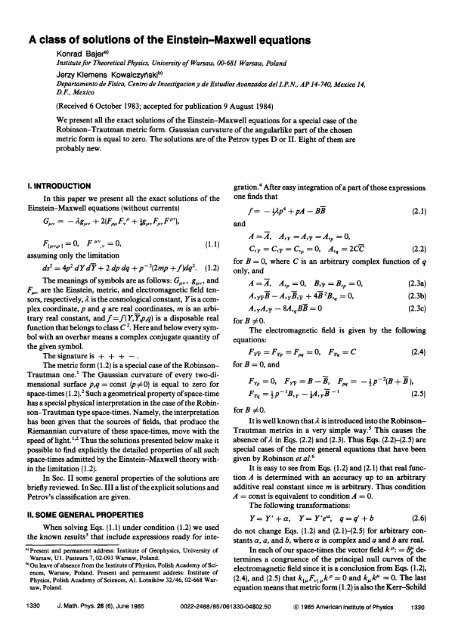


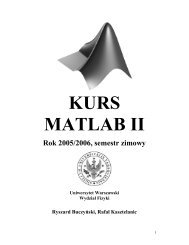
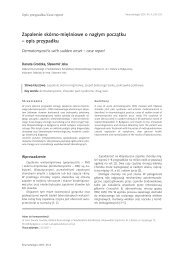
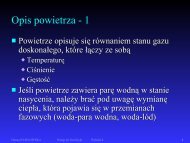
![slajdy [PDF, 0,6 MiB] - Instytut Geofizyki](https://img.yumpu.com/22546539/1/190x143/slajdy-pdf-06-mib-instytut-geofizyki.jpg?quality=85)
